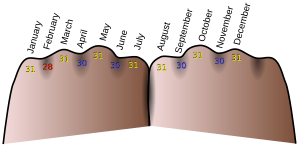Mnemonic facts for kids
A mnemonic (say it: neh-MON-ik) is a clever trick to help you remember things more easily! It's like a secret code or a special phrase that makes facts stick in your brain.
For example, if you play music, you might need to remember the notes on the lines of the treble clef: E, G, B, D, and F. A popular mnemonic for this is: Every Good Boy Does Fine. Each first letter helps you remember the note!

People have been using mnemonics for a very long time. The first known ones were used by the Ancient Greeks. A famous Roman speaker named Cicero said that a poet named Simonides of Ceos (who lived around 556 to 468 BC) discovered how powerful mnemonics could be. Simonides found that making mental pictures helped him remember things better.
The word mnemonic comes from old Greek words: mnene, which means "memory," and mnemon, which means "mindful" or "remembering."
Contents
How Do Mnemonics Work?
Mnemonics help your brain connect new information with things you already know. They often use funny images, rhymes, songs, or special words to make learning easier and more fun. When you use a mnemonic, you're creating a strong link in your memory. This makes it much simpler to recall information later, especially when you're taking a test or just trying to remember something important.
Why Are Mnemonics Useful?
Mnemonics are super helpful because they:
- Make boring facts more interesting.
- Help you remember long lists or sequences.
- Improve your memory for school subjects like history, science, and languages.
- Can be used for almost anything you need to memorize!
Types of Mnemonics
There are many different kinds of mnemonics. Here are some popular ones:
Acronyms and Acrostics
- An acronym is a word made from the first letters of other words. For example, "HOMES" is an acronym for the Great Lakes: Huron, Ontario, Michigan, Erie, and Superior.
- An acrostic is a sentence or phrase where each word's first letter helps you remember something. The "Every Good Boy Does Fine" example for music notes is an acrostic. Another one is "My Very Educated Mother Just Served Us Noodles" for the order of planets (Mercury, Venus, Earth, Mars, Jupiter, Saturn, Uranus, Neptune).
Rhymes and Songs
- Rhymes are easy to remember because of their rhythm and sound. Think of "Thirty days hath September, April, June, and November..." to remember the number of days in each month.
- Songs can also be great mnemonics. Many kids learn the alphabet by singing the "ABC song."
Visual Mnemonics
- This type uses pictures or mental images. For example, to remember that "cat" is spelled C-A-T, you might imagine a cat wearing a chef's hat (C), an apple (A), and a tie (T). The more unusual or funny the image, the easier it is to remember!
- The "knuckle mnemonic" for months is a visual and kinesthetic (body movement) mnemonic.
Method of Loci (Memory Palace)
- This is an ancient technique where you imagine a familiar place, like your house, and "place" items you want to remember in different spots within that place. To recall the items, you take a mental walk through your house and "pick up" each item. This method was used by the Ancient Greeks and Romans to remember long speeches.
Images for kids
-
Detail of Giordano Bruno's statue in Rome. Bruno was famous for his mnemonics, some of which he included in his treatises De umbris idearum and Ars Memoriae.
See also
 In Spanish: Regla mnemotécnica para niños
In Spanish: Regla mnemotécnica para niños


